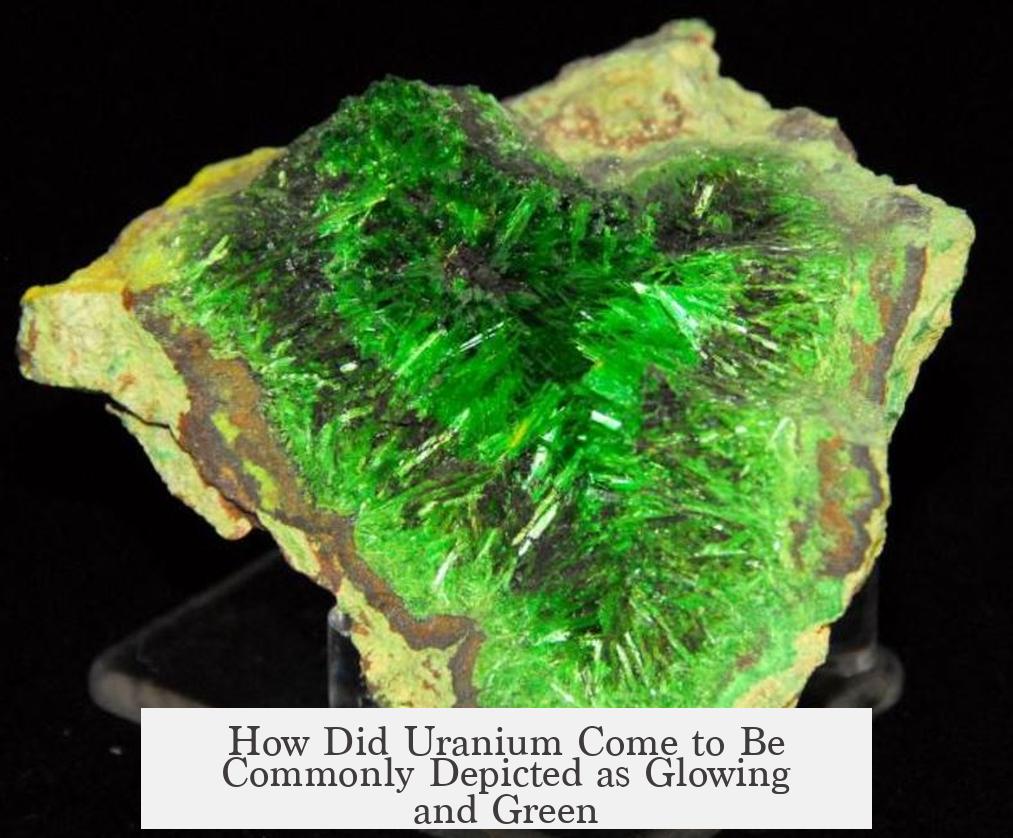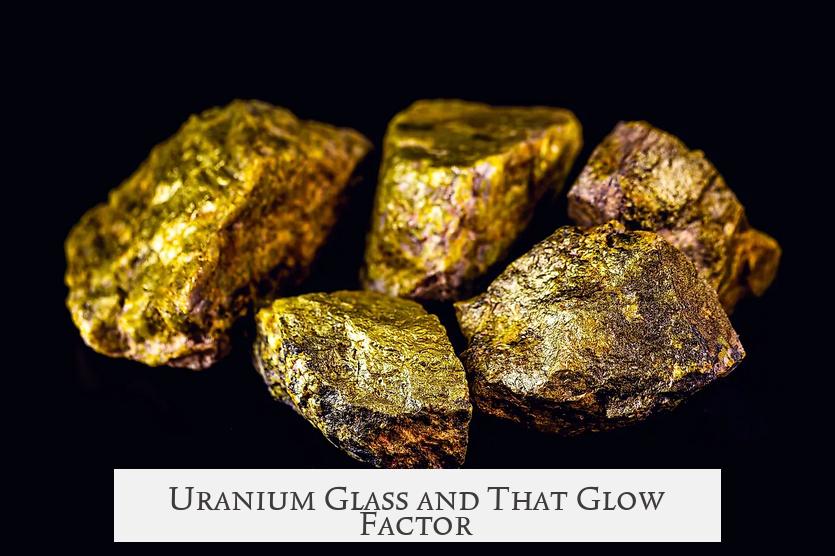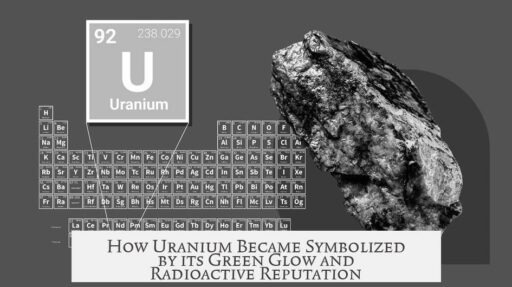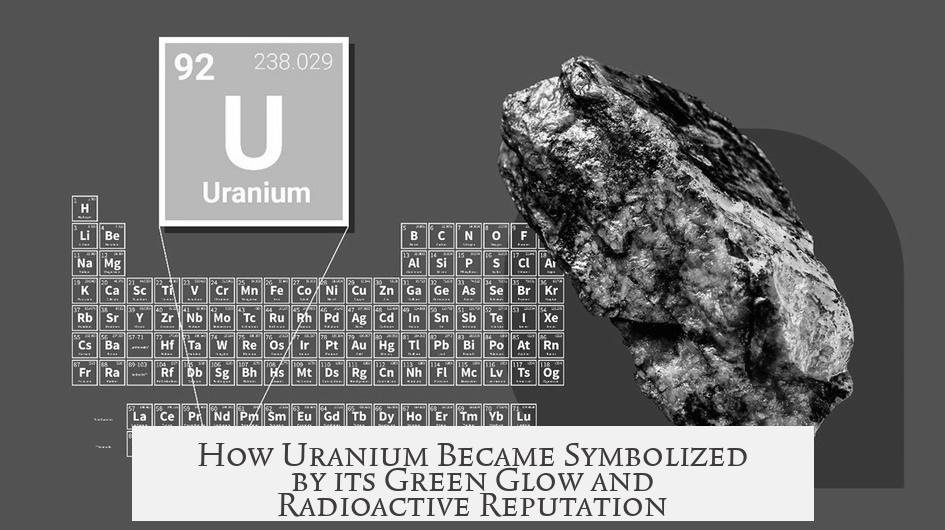Uranium is commonly depicted as glowing green due to cultural associations with radioactivity that trace back to radium, not uranium itself. The green glow imagery largely stems from radium’s use in radioluminescent paint, which emitted a greenish-yellow light. This shaped public perception of radioactivity as a green phenomenon from about the 1910s onward.
The idea that radioactivity glows green did not originate with uranium. Radium, discovered earlier, became famous for its faint greenish-yellow luminescence. Radium-based luminous paints allowed clock faces and instrument panels to glow in the dark. These paints gave off a characteristic green glow that captured public imagination through the early to mid-20th century. As a result, green became synonymous with radioactivity in culture and media, even though it scientifically diverges from many actual appearances of radioactive materials.
Uranium ore itself exhibits a variety of colors, none universally green. Its coloration depends on the uranium concentration and the mixture of other minerals. Low-grade uranium ores, common in places like the U.S. Southwest, usually have a dusty yellow tone. This type of ore was widely seen during the 1950s uranium boom. Government incentives led to increased uranium prospecting, and popular culture images from that era often show yellow-hued uranium ore.
“Yellowcake,” a processed uranium oxide powder used as an intermediate step in uranium refining, is distinctly yellow. This substance was critical during the uranium boom and nuclear development phases. However, uranium compounds vary in color beyond yellow. Uranium tetrafluoride, sometimes called “green salt,” presents a green coloration. This shows that while uranium metal itself is not green, some chemical forms of uranium do have greenish hues.
High-grade uranium ores can indeed be green. For example, uranium ores from the Congo display strong green colors due to specific mineral compositions such as torbernite and uranophane. These uranium-containing minerals exhibit vivid green shades that contrast with the more common yellow or brown uranium-bearing rocks elsewhere. This green appearance reinforces the occasional real-world basis for uranium’s green imagery, even if less commonly seen.
Uranium’s use in glassmaking during the early 20th century added to its association with green glow. Uranium glass, popular in the 1920s, has a pale yellow-green tint. When exposed to ultraviolet or black light, uranium glass fluoresces bright green. This distinct glow captured attention as a curious property of uranium compounds. Thus, uranium glass contributed to the cultural motif of uranium-related green luminescence, though the effect depends on specific conditions like UV exposure.
It is important to note that metallic uranium does not appear green. Uranium in its pure metal form is silvery-gray. Therefore, depictions of solid uranium metal glowing green are scientifically inaccurate. The green glow imagery relates primarily to radium’s luminescence, uranium compounds in ores or glass, and cultural interpretations rather than uranium metal itself.
In summary, the glowing green depiction of uranium arises from several linked factors:
- Historical association of green glow with radium-based luminous materials.
- Presence of green-colored uranium minerals in some high-grade ores.
- Coloration and fluorescence of uranium glass under ultraviolet light.
- Popular culture and media reinforcing the “green radioactivity” stereotype since the early 20th century.
The overall cultural idea that radioactivity glows green primarily descends from radium’s radioluminescent paint, not uranium’s properties. Uranium ore colors vary widely; some ores are yellow or brown, while select minerals can appear green. Uranium metal is not green or luminescent. Uranium glass’s UV-induced green fluorescence further enhanced uranium’s green-associated image in public consciousness, alongside radium’s well-known glow.
| Material/Form | Color/Glow Characteristics | Notes |
|---|---|---|
| Radium Radioluminescent Paint | Greenish-yellow glow | Primary source of radioactive green glow association |
| Uranium Ore (Low-grade, US Southwest) | Dusty yellow | Common appearance in popular depictions |
| Uranium Ore (High-grade, Congo) | Bright green | Due to minerals like torbernite, uranophane |
| Yellowcake (Uranium oxide) | Yellow | Intermediate processed uranium material |
| Uranium tetrafluoride (“green salt”) | Green | One of many uranium chemical forms |
| Uranium Glass | Pale yellow-green; fluoresces bright green under UV | Popular in 1920s; glows green under black light |
| Uranium Metal | Silvery-gray (non-green) | Not luminescent or green |
The strong cultural picture of radioactive materials glowing bright green endures, even though the scientific reality is more varied. This association began with radium and extended through uranium glass and certain uranium minerals. It provided a simple visual cue to help people identify radioactivity in fiction, education, and media. While not strictly accurate for uranium metal or many uranium ores, the green glow served as a memorable symbol for radioactive danger in the public imagination.
- Green glow in radioactivity culture originates from radium paint.
- Uranium ore colors vary; most are yellow or brown, some high-grade ores are green.
- Uranium metal is silvery-gray and not green.
- Uranium glass fluoresces green under UV, enhancing uranium’s green association.
- Popular depictions conflate uranium with radium’s green luminescence.
How Did Uranium Come to Be Commonly Depicted as Glowing and Green?

The short answer is: uranium is not inherently glowing or green, but the cultural image of “radioactive green” comes from radium’s greenish-yellow radioluminescent glow and the colorful appearances of uranium ores and products. This common depiction blends fact, folklore, and a splash of 20th-century marketing magic.
Let’s unpack this colorful mystery. Why do movies, comics, and pop culture often show uranium as a glowing green rock? Is uranium really glowing like that? And where did this idea even start?
Green and Radioactivity: A Cultural Color Code
It all begins with radium. Back in the 1910s, radium was discovered and became famous for its eerie glow. It often had a greenish-yellow radiance thanks to radium-based luminescent paint applied to clocks, instrument dials, and watch faces. This was before we fully understood radioactivity’s dangers, so radium’s glow seemed magical and mesmerizing.
From this early exposure, the public started to connect the color green firmly with radioactivity. So, green = radioactive became an ingrained cultural shorthand.
Interestingly, that’s a bit ironic because Cherenkov radiation—the blue glow sometimes seen in nuclear reactors—is actually a more scientifically accurate “radioactive glow.” But blue just doesn’t have the same spooky vibe as green, does it?
Uranium Ore: A Visual Spectrum Beyond Green
Here’s where things get a bit more nuanced. Uranium in its natural rock form varies wildly in appearance based on several factors:
- Content of uranium: The amount of uranium inside the ore influences color and texture.
- Other minerals present: Surrounding mineral compositions often alter the rock’s hue.
For example, low-grade uranium ores from the US Southwest generally exhibit a dusty yellow appearance. This color shows up in many mid-century posters and ads, especially during the 1950s uranium boom when the government encouraged uranium prospecting by setting a high price for the mineral.
Yellow uranium? Not exactly what you expected if your image comes from comic books or sci-fi movies.
There’s also yellowcake, a concentrated form of uranium oxide produced during uranium processing. As the name suggests, it’s yellow. But uranium can also come in other colors once separated. Take uranium tetrafluoride, called “green salt.” The name says it all: a green uranium compound, adding some green reality to the pop culture narrative.
And if you head over to high-grade ores from places like the Congo, you’ll find uranium ores that are genuinely green—very green indeed. These pieces often feature minerals like torbernite or uranophane that sport beautiful rich green hues.
Uranium Glass and That Glow Factor

In the 1920s, uranium found fame beyond nuclear science; it showcased its aesthetic side by being added to glassware. Uranium glass is pale yellow-green in natural light and becomes vividly bright green under ultraviolet (black) light.
This distinctive glow gave rise to the idea that uranium glows green inherently—which only happens under special lighting conditions. The uranium’s radioactivity in the glass is weak, but the fluorescent effect is impressive enough to inspire legends.
Uranium Metal: The Not-So-Green Truth
Contrary to popular images, uranium metal itself doesn’t glow green or look green. It is a silvery-grey metal, dull and unassuming. So if your mental picture involves a glowing green chunk of uranium metal, this is where reality distinctly parts ways from the glowing fantasy.
Wrapping It Up: The Glow Gets Colored by History
When you see glowing green rocks in movies or comics labeled as uranium, remember that this is mostly a cultural symbol drawn from radium’s glow and colored by the hues of ore and processed uranium compounds.
The popular image is a blend of:
- Radium’s early 20th-century greenish-yellow radioluminescent paint creating the initial “green glow” association.
- The variable and occasionally green colors of uranium ores, especially high-grade ores from the Congo and compounds like uranium tetrafluoride.
- The bright green glow of uranium glass under black light adding dramatic visual appeal.
So, uranium’s glowing green portrayal is more a cultural echo than a simple scientific truth.
What Does This Mean for Curious Minds?
If you stumble across a “glowing green” uranium rock in a game, movie, or story, pause and appreciate the layers behind that image. It’s a tale of scientific discovery, public perception, and creative imagination. Sure, uranium glows under special conditions, and some uranium minerals can be green. But it’s radium’s radiance and the bright hues of uranium glass that truly sparked this colorful legend.
And next time you see a cartoonish glowing green radioactive isotope, you’ll know just why that color became radioactive’s unofficial emblem—and why uranium’s actual shade is often more yellow or grey than green.




